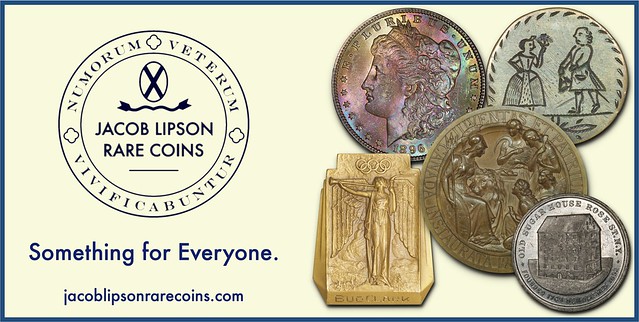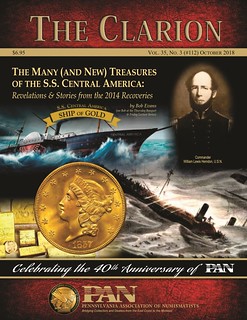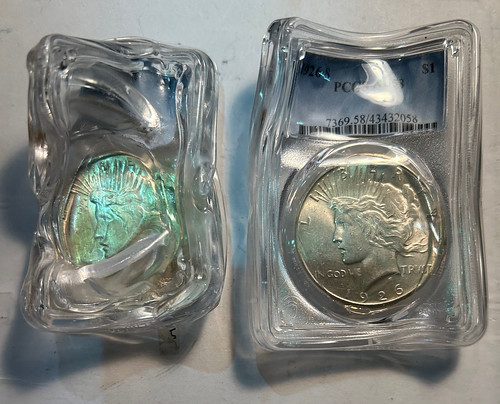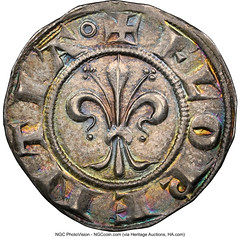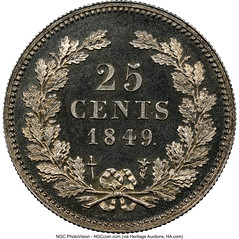
Visit our NBS Sponsors



About UsThe Numismatic Bibliomania Society is a non-profit association devoted to the study and enjoyment of numismatic literature. For more information please see our web site at coinbooks.org SubscriptionsThose wishing to become new E-Sylum subscribers (or wishing to Unsubscribe) can go to the following web page link MembershipThere is a membership application available on the web site Membership Application To join, print the application and return it with your check to the address printed on the application. Print/Digital membership is $40 to addresses in the U.S., and $60 elsewhere. A digital-only membership is available for $25. For those without web access, write to: Jeff Dickerson, Treasurer AsylumFor Asylum mailing address changes and other membership questions, contact Jeff at this email address: treasurer@coinbooks.org SubmissionsTo submit items for publication in The E-Sylum, write to the Editor at this address: whomren@gmail.com BUY THE BOOK BEFORE THE COINSale CalendarWatch here for updates! |
- WAYNE'S WORDS: THE E-SYLUM AUGUST 18, 2024
- 2024 NBS CHARITY AUCTION RESULTS
- NBS BIBLIOTALK PODCAST WITH DAN HAMELBERG
- NEW BOOK: COINS OF THE GRAND DUCHY OF RYAZAN
- NEW BOOK: HISTORICAL EVIDENCE AND ITS INTERPRETATION
- EUGENE DAUB BOOK UPDATE
- RAYMOND HENRY MASSEY (1935-2024)
- FRIEDRICH POPKEN (1940-2024)
- RICHARD CULLEN JEWELL (1945-2024)
- ANS TRAVELING EXHIBIT, 1926-1928
- VIDEO: CALIFORNIA PIONEER FRACTIONAL GOLD
- MORE ON THE MYSTERIOUS WARPED SLABS
- THE EMPIRE COIN COMPANY WINDOW
- NOTES FROM E-SYLUM READERS: AUGUST 18, 2024
- HOW TO DECORATE YOUR YACHT
- CURSED GOLD: A SHIPWRECK SCANDAL
- VOCABULARY TERM: PRESSES, PART 1
- LYSANDER SPOONER (1808-1887)
- ERIC SCHENA INTERVIEW, PART SIX
- NUMISMAGRAM MEDAL SELECTIONS: AUGUST 18, 2024
- HOLABIRD AUGUST 2024 AUCTION SELECTIONS
- HERITAGE ANA WORLD & ANCIENT SELECTIONS
- GADOURY OCTOBER 25-26, 2024 SALE, PART I
- WAYNE'S NUMISMATIC DIARY: AUGUST 11, 2024, PART II
- WAYNE'S NUMISMATIC DIARY: AUGUST 11, 2024, PART III
- HOARD FOUND IN PLOVDIV, BULGARIA
- HOARD FOUND IN GERMANY'S BLACK FOREST
- SAMPLE SLABS HAVE GONE MAINSTREAM
- A LAKI PAINTING ON A SRI LANKA BANKNOTE
Content presented in The E-Sylum is not necessarily researched or independently fact-checked, and views expressed do not necessarily represent those of the Numismatic Bibliomania Society.
WAYNE'S WORDS: THE E-SYLUM AUGUST 18, 2024
 Thank you for reading The E-Sylum. If you enjoy it, please send me the email addresses of friends you think may enjoy it as well and I'll send them a subscription. Contact me at whomren@gmail.com anytime regarding your subscription, or questions, comments or suggestions about our content.
Thank you for reading The E-Sylum. If you enjoy it, please send me the email addresses of friends you think may enjoy it as well and I'll send them a subscription. Contact me at whomren@gmail.com anytime regarding your subscription, or questions, comments or suggestions about our content.
This week we open with Charity Auction results and other NBS news, two new books, three obituaries, updates from the Newman Numismatic Portal, and more.
Other topics this week include the Empire Coin Company, warped slabs, decorative ancient coin plaques, Tommy Thompson and the SS Central America treasure, Lysander Spooner, Eric Schena, fixed price and auction offerings, my ANA diaries, two coin hoards, and sample slabs.
To learn more about Out on a Limb, Dan Hamelberg, the Grand Duchy of Ryazan, the ANS Traveling Exhibit, coin presses, mortgage-backed paper money, the Farmers Bank of Virginia at Winchester, rare Confederate currency, the siege of Oudewater, the Naseby Cup, and unchaste men and women, read on. Have a great week, everyone!
Wayne Homren
Editor, The E-Sylum
2024 NBS CHARITY AUCTION RESULTS
Numismatic Bibliomania Society President Len Augsburger submitted this report on the recent charity auction. -Editor
NBS Charity Auction Raises Funds for NBS Treasury
 The NBS Charity Auction, an offering of 50 lots donated by club members, took place on August 9 at the ANA World’s Fair of Money in Rosemont, IL. David Fanning wrote the auction sale catalog and called the sale. Printed copies of the catalog were on hand for attendees. Highlights included the Eric P. Newman library card catalog, donated by the Eric P. Newman Numismatic Education Society, which realized $1,600. A rare piece of early Bowersiana, a 1957 price paid for list, raised $650 for the NBS in active bidding. Dan Hamelberg donated this lot. David Steine contributed a plated Elder sale (1907), which sold for $650. A set of Out on a Limb, the highly entertaining house organ of The Money Tree, donated by Tom Harrison, brought $300. The sale realized a total of $7,885. NBS acknowledges both donors and bidders for their continued support.
The NBS Charity Auction, an offering of 50 lots donated by club members, took place on August 9 at the ANA World’s Fair of Money in Rosemont, IL. David Fanning wrote the auction sale catalog and called the sale. Printed copies of the catalog were on hand for attendees. Highlights included the Eric P. Newman library card catalog, donated by the Eric P. Newman Numismatic Education Society, which realized $1,600. A rare piece of early Bowersiana, a 1957 price paid for list, raised $650 for the NBS in active bidding. Dan Hamelberg donated this lot. David Steine contributed a plated Elder sale (1907), which sold for $650. A set of Out on a Limb, the highly entertaining house organ of The Money Tree, donated by Tom Harrison, brought $300. The sale realized a total of $7,885. NBS acknowledges both donors and bidders for their continued support.
NBS BIBLIOTALK PODCAST WITH DAN HAMELBERG
The latest episode of the Numismatic Bibliomania Society podcast is now available for listening. It's on the NBS web site but also available elsewhere. President Len Augsburger provided this report. -Editor
NBS Podcast Features Literature Collector Dan Hamelberg
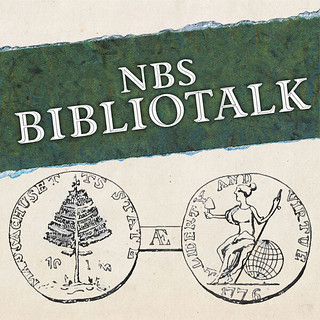 The latest episode of the NBS Bibliotalk podcast, "Collection Highlights Continued, with Dan Hamelberg" is now available on the NBS website and other popular podcasting platforms such as Buzzsprout. Dan needs no introduction to those familiar with numismatic literature collecting, and in this episode shares another round of highlights from his unparalleled library.
The latest episode of the NBS Bibliotalk podcast, "Collection Highlights Continued, with Dan Hamelberg" is now available on the NBS website and other popular podcasting platforms such as Buzzsprout. Dan needs no introduction to those familiar with numismatic literature collecting, and in this episode shares another round of highlights from his unparalleled library.
Recorded on June 21, Dan begins with the tale of an unlikely connection between B. Max Mehl’s printing blocks and Martin Gengerke’s American Numismatic Auctions. Discussion of the F.C.C. Boyd inventory of the Col. Green collection follows, along with background on the colonel’s mother, Hetty Green, the so-called "witch of Wall Street." From there Dan presents numismatic-themed manuscript documents including letters of U.S. Mint Directors and Engravers. This portion of the interview (part 1 of 2) finishes with an Ephraim Brasher-signed letter, of the few known items signed by Brasher. Part 2 of the interview will be released in due course.
NEW BOOK: COINS OF THE GRAND DUCHY OF RYAZAN
Dzmitry Huletski has published a new book on coins from the Grand Duchy of Ryazan. While available in Russia, we are not aware yet of a source for the book elsewhere. -Editor
Coins of the Grand Duchy of Ryazan (late 14th to mid-15th centuries)
D. Huletski, K. Petrunin
 Coins from the Grand Duchy of Ryazan, spanning the late 14th to mid-15th centuries, present a distinctive monetary system within lands of Ancient Rus'. Distinguished by unique minting techniques and the remarkable variety of countermarks, these coins have long fascinated numismatists.
Coins from the Grand Duchy of Ryazan, spanning the late 14th to mid-15th centuries, present a distinctive monetary system within lands of Ancient Rus'. Distinguished by unique minting techniques and the remarkable variety of countermarks, these coins have long fascinated numismatists.
The uniqueness of the Ryazan coinage is that having begun as a counterstamping of the Ulus of Jochi dangs, it did not abandon this tradition even after the influx of Jochid coins ceased. At local mints, imitations were first produced, and then they were re-coined with another, smaller stamp, imitating the counterstamping technique.
Attributing these coins accurately poses challenges due to their often anonymous and anepigraphic nature. This study endeavours to shed light on their origins through graphic reconstructions of dies and analysis of die connections between base coins and countermarks. These efforts serve as the primary method for dating and understanding the coinage of the Ryazan princes.
NEW BOOK: HISTORICAL EVIDENCE AND ITS INTERPRETATION
A new book by Kiran Kumar Thaplyal discusses separating fact from fiction in interpreting and researching Indian coinage. -Editor
Historical Evidence and Its Interpretation
Kiran Kumar Thaplyal
 The evidences discussed in 16 chapters and four appendices relate variously to determining the date and chronology, political history, polity and administration, religion and iconography, and social and economic life. An evidence when corroborated becomes strong, and when contradicted, turns weak, and the stronger the evidence, the more definite the conclusion. Some evidences are clear-cut, while others are vague, some are mutually conflicting and some variously contain mythology, exaggerations, stock phraseology, fabricated genealogy and forged account. Primary source is preferable to the secondary, and eye-witness to hearsay. Facts should be separated from fiction, actual from normative, original from fake, and certain from doubtful. The conclusions are drawn variously as probable, possible, potential or certain.
The evidences discussed in 16 chapters and four appendices relate variously to determining the date and chronology, political history, polity and administration, religion and iconography, and social and economic life. An evidence when corroborated becomes strong, and when contradicted, turns weak, and the stronger the evidence, the more definite the conclusion. Some evidences are clear-cut, while others are vague, some are mutually conflicting and some variously contain mythology, exaggerations, stock phraseology, fabricated genealogy and forged account. Primary source is preferable to the secondary, and eye-witness to hearsay. Facts should be separated from fiction, actual from normative, original from fake, and certain from doubtful. The conclusions are drawn variously as probable, possible, potential or certain.
A few interpretations by scholars are interesting. The similarity of helmet and even that of smile of kings in coin-portraits is taken as evidence for their belonging to the same family. The title philopator (beloved of father) does not absolve a king of the blame of patricide. From coin portraits of Strato I, coins issued as a child, as an adult and as an old man have been identifi ed. Punctuating an unpunctuated epigraphic passage in one way, a lady is taken as a daughter of a person, and punctuating it another way, as his mother. New discoveries have brought changes in history.
EUGENE DAUB BOOK UPDATE
Last week we discussed a planned book on the work of sculptor and medal designer Eugene Daub. I contributed to the project, and received this update yesterday. -Editor
Adolfo Nodal writes:
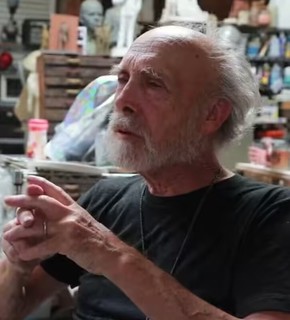 "First, we want to thank you for your support and let you know that, thanks to you, we are moving forward really well in our effort to create this book for Eugene Daub.
"First, we want to thank you for your support and let you know that, thanks to you, we are moving forward really well in our effort to create this book for Eugene Daub.
"We are over half way and steadily closing in on our goal. Currently we are only $7,500 short and we are working on that. The big news is that we actually started the hard design and editorial work to get the material ready for printing. Our printer is on standby. We are that close!"
RAYMOND HENRY MASSEY (1935-2024)
Manitoba Coin Club Archivist & Historian Howard R. Engel submitted this report on the passing of longtime MCC member Ray Massey. Thank you. -Editor
Howard writes:
"I have fond memories of Ray as a club fixture, who served as our Treasurer for more than two decades from the early 1990s through the mid 2010s. With good humour, he kept his colleagues on their toes and in line with his clear, no-nonsense regular reporting of our financial situation.
"He was an avid collector, especially of Canadian decimal, paper money and municipal trade dollars for over 30 years. His passion for the hobby shone through his sometimes gruff (but never rude), business-like exterior, and he would often contribute uncommon and intriguing pieces to Club auctions.
"He and his late wife, Fern, made a great team as they volunteered countless hours to the Club, for which they both received joint Life Membership recognition on Feb. 26, 2020. In addition to his Treasurer responsibilities, Ray would typically take care of calling out our hourly show raffles as Fern helped to staff the registration table. Of course, he was not the same and slowed down noticeably after Fern passed just over two years ago. He nonetheless did his best to attend monthly meetings at the Royal Canadian Mint's 2nd floor training room as his health would allow. Incidentally, MCC, which is marking its 70th anniversary this year, is unique in Canada in that it has the privilege of being the only coin club that holds its regular monthly meetings at such a prestige venue as the RCM's Winnipeg facility.
"At one of the last meetings he attended, I'm pleased to have acquired his silver 2013 RCNA Convention Medal, the last year MCC hosted that convention, at which both he and Fern were very active, as the Finance Committee and Hospitality Committee Chairs, respectively. Now both together again, they will be greatly missed by all who knew them.
"Thank you, Ray and Fern, for your enthusiasm for our hobby and for your faithful service to MCC! May you now both rest in peace!"
FRIEDRICH POPKEN (1940-2024)
This remembrance of collector Friedrich Popken was penned by dealer Fritz Rudolf Künker. -Editor
FRIEDRICH POPKEN, Awardee of the Lower Saxony Order of Merit
(*16 February 1940 in Hameln, †27 July 2024 in Rastede)
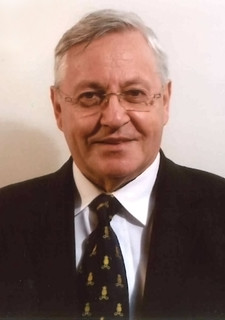 On 27 July 2024, Friedrich Popken passed away at the age of 84. As well as being a well-known entrepreneur, he was also a highly esteemed coin collector and a friend of the Künker auction house.
On 27 July 2024, Friedrich Popken passed away at the age of 84. As well as being a well-known entrepreneur, he was also a highly esteemed coin collector and a friend of the Künker auction house.
When Friedrich Popken was born on 16 February 1940, no one could have imagined that he would go on to create the Ulla Popken brand, bringing unprecedented success to the Popken family business.
The Popken family had been living in Frisia, Germany, for centuries. His great-grandfather, Thade Boiken Popken, had been a farmer before selling his farmstead to the Prussian state in the mid-19th century, when Prussia was essentially building the largest German naval base from scratch in Wilhelmshaven. The great-grandfather became very successful with his haulage business in Wilhelmshaven and left his heirs a substantial sum of 140,000 gold marks in 1881. One of his sons, Johann Popken, the grandfather of Friedrich Popken, founded the clothing store J. Popken in 1880 in Hameln. Following Johann Popken’s early death in 1905, his wife Elisabeth successfully steered the company through the turmoil of the First World War (1914-1918), German hyperinflation (1919-1923) and the Great Depression (1929-1932).
RICHARD CULLEN JEWELL (1945-2024)
I was very sad to learn of the recent passing of collector Rich Jewell. Born on February 14th (Valentine's Day), he was a lovable figure with the Pennsylvania Association of Numismatists, continuing his work as Editor of their journal The Clarion even while spending much of his retirement far from his home base near Pittsburgh. -Editor
On August 10, 2024, Richard Cullen Jewell, 79, of Franklin Park, beloved husband of 50 years to Fran Jewell, passed away peacefully.
Richard was a prominent member of the PA Association of Numismatists (Coin Collecting), the editor of the Clarion magazine, a member of the American Numismatic Association, Cape Fear, George Washington and North Hills Coin Clubs and various other organizations. He was a huge sports fan and could always be counted on to tell you the latest joke.
He retired from the United States Air Force in 1967, where he was a Sergeant in the 623rd ACW.
ANS TRAVELING EXHIBIT, 1926-1928
The latest addition to the Newman Numismatic Portal is correspondence of ANS Curator Howland Wood. Project Coordinator Len Augsburger provided the following report. -Editor
American Numismatic Society Traveling Exhibit, 1926-1928
Scanning of the ANS Curator (Howland Wood) correspondence, covering the period 1913-1937, continues apace under the sponsorship of the Newman Numismatic Portal. Correspondents through the letters A-P are now processed. A recently scanned file details a traveling exhibit mounted by the ANS in the 1920s. Curator Wood explained in correspondence to the Smithsonian on November 22, 1926:
"This exhibit is of coins and tends to show the development of coinage from its inception, about 750 B.C., to the present days. It is arranged by centuries, ten coins to a row (or century), 260 coins in all, and if laid out with plenty of room will occupy about twenty square feat. Labels have been printed in two colors: master labels for the exhibit, labels for each century, and individual placards under each coin."
VIDEO: CALIFORNIA PIONEER FRACTIONAL GOLD
The David Lisot Video Library on the Newman Numismatic Portal can be found at:
https://nnp.wustl.edu/library/multimediadetail/522852
We highlight one of his videos each week in The E-Sylum. Here's one from 2009 with Dennis Beasley speaking about California Pioneer Fractional Gold' -Editor
MORE ON THE MYSTERIOUS WARPED SLABS
Last week Pete Smith passed along photos of two warped coin slabs he found at the ANA show table of Dave Wnuck. Here are reader thoughts. -Editor
Dave Wnuck writes:
"I don't have too much to add to his description. Both coins came out of an estate in Connecticut. The person who inherited the collection had no idea how they got this way. There were a number of other slabs in the collection, but none were like this."
THE EMPIRE COIN COMPANY WINDOW
Heath MacAlpine submitted these notes and images about the Empire Coin Company. Thank you. -Editor
The August 4th issue of The E-Sylum had an interesting article originating with Doug Nyholm, editor of the Utah Numismatic Society’s The Mint Master, regarding the early publications of Q. David Bowers while he and James Ruddy were operating the Empire Coin Company. It featured a photo of the upper half of the front page of the July-August-September 1958 issue of Empire Topics, the house organ.
While the sixty-six-year-old article was about the teams’ purchase of a rare 1894-S Barber dime, my attention was captured by something more mundane. The publication’s heading included the firm’s address, 252 Main Street in Johnson City, New York. What, I wondered, was currently located at that long ago address of this important figure in modern numismatics.
NOTES FROM E-SYLUM READERS: AUGUST 18, 2024
Monitor vs Merrimack/Merrimac
 #1 Money Man writes:
#1 Money Man writes:
"Here's a picture of a New Orleans, Mobile & Texas Rail Road Co. 1872 $1,000 Bond complete with all 80 Coupons - Signed by John Griswold (steel mills owner and Mayor of Troy, NY), 1 of 4 partners responsible for building the USS Monitor used in first naval battle between ironclads in America during the Civil War in March of 1862 (Monitor vs Merrimack) at Hampton Roads."
Thanks. So, is it 'Merrimack' with a 'ck' or 'Merrimac' with a 'c' ? -Editor
Dick Hanscom writes:
"I grew up in Newburyport, Mass., on the Merrimac River. My family has owned property on Merrimac St. since the early 1900s. Upriver from Newburyport is Merrimac, Mass. The artifacts are from the U.S.S. Merrimac.
So where the "K" comes from, I am at a loss. Everytime I see it spelled with the "K", I cringe."

The relic items Dave Schenkman pictured were stamped 'Merrimac', but I do see references online (including a U.S. Navy site) calling it the 'Merrimack'. Is Dick correct? -Editor
To read the earlier E-Sylum article, see:
SCHENKMAN PRESENTS USS MERRIMACK RELICS
(https://www.coinbooks.org/v27/esylum_v27n32a03.html)
Other topics this week include the Mesopotamian Shekel, and the Proskey/Low Fractional Currency Price List. -Editor
HOW TO DECORATE YOUR YACHT
Rob Luton writes:
"I found these four bronze plaques (about 5" in diameter) at a local tag sale auction. What caught my eye of course was their being modeled after ancient Greek coins. The note that accompanied them suggested they were originally installed in 1962 in a 180 foot yacht made for Artemis Garoufallidi (sister of Aristotle Onassis and sister-in-law to Jackie O). A bit of web research suggested the interior was designed by Jon Bannenberg and yet when I contacted his son, he made it clear that his father had not worked on this boat. I was however able to reach the archivist/historian for the yacht maker, Lurssen who was able to confirm that these plaques (along with at least a few others) did indeed hang in the Pegasus II yacht."
Very cool. Rob forwarded these photos of the yacht exterior and interior, showing where the plaques had been installed. Thanks! -Editor
CURSED GOLD: A SHIPWRECK SCANDAL
On September 8, 2024 National Geographic will air (er, "drop") a new series on SS Central America project leader Tommy Thompson. Here's a review I came across online.-Editor
 The new 3-episode series from National Geographic takes viewers back to the year 1989 to explore the story of Tommy Thompson, the man who discovered the SS Central America. Within the excitement of discovery and potential riches lies a tale of deceit and turmoil. The new National Geographic show Cursed Gold: A Shipwreck Scandal premieres on September 8th.
The new 3-episode series from National Geographic takes viewers back to the year 1989 to explore the story of Tommy Thompson, the man who discovered the SS Central America. Within the excitement of discovery and potential riches lies a tale of deceit and turmoil. The new National Geographic show Cursed Gold: A Shipwreck Scandal premieres on September 8th.
In the Reagan years, many Americans were all about getting rich. Tommy Thompson was no exception. The young inventor who majored in Engineering at Ohio State University became obsessed with the SS Central America. Also known as the "ship of gold," the SS Central America sank September 12th 1857 carrying 30,000 pounds of the precious resource. The disaster took the lives of over 400 people and contributed to the Panic of 1957. Using his scientific skills and charm, Thompson began reaching out to investors to fund an expedition to find and collect gold from the wreck of the ship. With an initial investment of 1.5 million dollars, Thompson began his expedition to find the treasure. With huge setbacks and pressure from investors, Thompson eventually had over 12 million dollars from investors. He was unwilling to give up, and on one fateful day in 1989, Thompson and his crew located the SS Central America. The haul was the biggest American treasure ever found. At the time, the gold was estimated to be worth around 1 billion dollars.
VOCABULARY TERM: PRESSES, PART 1
Here's another entry from Dick Johnson's Encyclopedia of Coin and Medal Terminology. -Editor
Presses and Pressroom Practice. The machines in which coins and medals are struck and their operation. Presswork and presses replaced hammer coinage with coins created manually one blow at a time. Presses have evolved from manual hammer and screw presses to mechanical machines that spew out tens of thousands of pieces struck an hour in modern times. Factors of impression, speed, control and maintaining sustained quality have been important in press design and construction over the years. The pressroom – usually with presses of several makers or types – is where coins and medals come to life by die stamping under the watchful eye of a skilled pressman, the press operators and their foremen. As the need for coins increase, national mints have banks of coining presses, long rows of presses capable of spouting out large quantities of struck pieces.
LYSANDER SPOONER (1808-1887)
E-Sylum Feature Writer and American Numismatic Biographies author Pete Smith submitted this article on Lysander Spooner's scheme for land-backed paper money. Thanks! -Editor
 Lysander Spooner had a lot of ideas about capitalism and finance. He expressed some of these
ideas in his 1861 book, A New System of Paper Currency. He suggested that money should not
be in coins backed by the trust of the government, but rather, backed by physical property, such
as mortgages. His "invention" was not broadly successful.
Lysander Spooner had a lot of ideas about capitalism and finance. He expressed some of these
ideas in his 1861 book, A New System of Paper Currency. He suggested that money should not
be in coins backed by the trust of the government, but rather, backed by physical property, such
as mortgages. His "invention" was not broadly successful.
If Spooner had an opinion on something, he was likely to write a pamphlet about it. The Library of Congress lists 35 titles. He composed other manuscripts which were never published and have not survived.
Spooner was born on a farm near Athol, Massachusetts, on January 19, 1808. His parents were Asa Spooner (1778-1850) and Dolly Brown Spooner (1784-1845). From age sixteen to twenty-five, Lysander worked at the family farm. He left home to take a job in the office of Deeds and Records in Worcester, Massachusetts.
ERIC SCHENA INTERVIEW, PART SIX
Greg Bennick's latest interview for the Newman Numismatic Portal is with exonumia researcher and collector Eric Schena. Here's the sixth and final part, where Eric talks about his purchase of important documents from a Virginia bank, more on digitization, and an encouragement for collectors to learn more about their local history. -Editor
 ERIC SCHENA: Exactly. And there's a lot of scholars out there, putting shoe leather to ground, to go out there and doing all that legwork, trying to find all this stuff. I'll tell you another story. It's about my local town of Winchester. Many years ago, I was searching on eBay for random stuff around here. There was a ledger that showed up on eBay. And it was for a pre-Civil War bank that was based here. It was the Farmers Bank of Virginia at Winchester. And it was the board of directors meeting minutes from 1845 to 1849. It was on eBay. I bid on it. I won it. And I went to the dealer was local. So, I actually said, "Hey, why don't I just come by and pick it up?"
ERIC SCHENA: Exactly. And there's a lot of scholars out there, putting shoe leather to ground, to go out there and doing all that legwork, trying to find all this stuff. I'll tell you another story. It's about my local town of Winchester. Many years ago, I was searching on eBay for random stuff around here. There was a ledger that showed up on eBay. And it was for a pre-Civil War bank that was based here. It was the Farmers Bank of Virginia at Winchester. And it was the board of directors meeting minutes from 1845 to 1849. It was on eBay. I bid on it. I won it. And I went to the dealer was local. So, I actually said, "Hey, why don't I just come by and pick it up?"
And so, I drove to his place. And he pulled it out and started talking about it. Showed me the book. And it was in tatters. It had condition issues. I started flipping through it, and it was all kinds of great material in it. It had vault inventories. They met every two weeks, every Thursday, if I remember correctly. Twice a month on a Thursday. And they would talk about all the bank's business. They would talk about loaning money to the fire damaged Taylor Hotel, which is now in the walking mall in Winchester. They would talk about returning spoiled banknotes back to the mother bank in Richmond for destruction. Things like that. All sorts of little pieces of information. It was all throughout it.
It would say that X number of $30 bills were in circulation. And, yes, that was a bank that used $30 bills. They were still in use. At that particular point in time. It would talk about them coming over the counter and stuff like that. And I started saying, this is a great resource. He looked at me and he said, you know, I'm glad that you bought this, because you see that signature? That's James Murray Mason. James Murray Mason, for those who don't know, was Virginia senator from 1847 to 1861. He co-authored the Fugitive Slave Act of 1850. He's a grandson of George Mason. And he was president of the Winchester branch of the Farmers Bank of Virginia for a number of years.
He also happened to have been on, he's one of the 11 senators who were kicked out of the Senate for being secessionist. And so, because he was an ardent secessionist, and he joined the Confederate government as a plenipotentiary to Great Britain. And he was in British waters on the Trent when a U.S. warship intercepted it and arrested him and a gentleman by the name of James Slidell and arrested them in British waters. Parliament was incensed about that. Almost enough to join the cause on the Confederate side.
And one of the things that Lincoln said to his war secretary was, please, one war at a time. Find some way of settling this. This book was signed by Mason. Not only was it signed by Mason, the presiding president of the director of the board of directors, meaning would have to sign each entry at the end of it to acknowledge that that is true and correct. He signed the book about 33 times. And this gentleman was telling me that what would have happened to that book had it not sold on eBay, is he would have sold it to an, to an autograph collector or a dealer who would have cut out the autograph and tossed the rest of the book. Because they would take the autograph, frame it with like some nice picture of some Civil War scene, and sell that for $200, $300, $400, $500 a pop. They would do that. Throw the rest out.
GREG BENNICK: It's like, we're not just stewards of history, I think that at times without inflating our own importance, I think it goes without saying that we, we need to continue doing the work, the study, the research, the collecting we do because you might be saving history. I mean, incredible.
ERIC SCHENA: Yeah, not only did I have that book digitized, it's available on the Portal as matter of fact. I shipped it out so it could get scanned. I do want scholars to be able to access it. One of the neat things is when Mason was elected senator, he had to resign his position as bank president, and his resignation was read into the minutes. And so, there's a copy of that in the minutes, his resignation letter. And I can't think of what a piece of history that is. And that is something that would have been tossed, because someone would have just wanted that signature.
GREG BENNICK: I'm so inspired by our conversation. I'm inspired to go back to my collection and just like study and read and think and go through my whole library and do all the same. This has been amazing.
ERIC SCHENA: Yeah, it's amazing stuff, and I want to encourage a lot of other collectors to get out there and look into their local histories. Go to their local archives. Drive around, drive around. Just look at old stores. Some people are friendly. When you want to talk to them about the history of their old store buildings. It doesn't have to be Virginia. It doesn't have to be a ghost town in the West. It could be anywhere. Dayton, Ohio has a huge history in numismatics through the Ingle system and other die strikers and sinkers.
Go to Dayton, Ohio, anywhere, any place, Texas, any state of the union. There are going to be thousands upon thousands of tokens. And they're going to be issued by regular people doing their jobs. They just wanted to get paid. A lot of this stuff is stuff that, 150 years ago they didn't think anything of it. It just disappears unless we as collectors and stewards of that history go out and find it and record it. And so that's what I have tried to do with my numismatic career.
GREG BENNICK: I am so glad that we talked today. This has been absolutely wonderful. Is there anything that you'd like to add before we sign off? Because I think that that's a perfect ending point for us today.
ERIC SCHENA: Well, all I would have to say is, I would like to thank my very understanding wife and also some really great numismatists for helping me along the way. Dave Schenkman, Wayne Homren, and my coin dealer and mentor, Gene Brandenburg. Find someone like those people. And I would encourage anyone watching this video to go out and find someone like Dave or Gene or Wayne and learn from them. They have a wealth of history, a wealth of knowledge and expertise that you can draw upon. Learn from them. Listen to them. And go out there and collect and preserve that history.
GREG BENNICK: Fantastic. Eric, thank you so much for taking the time to be with us today. Really appreciate it. On behalf of the Newman Numismatic Portal, I'm Greg Bennick. Eric Schena, thank you so much for taking the time.
ERIC SCHENA: And thank you.
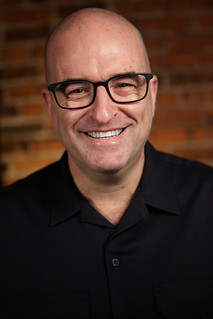 About the Interviewer
About the Interviewer
Greg Bennick (www.gregbennick.com) is a keynote speaker and long time coin collector with a focus on major mint error coins. Have ideas for other interviewees? Contact him anytime on the web or via instagram @minterrors.
To watch the complete video, see:
Eric Schena Interviewed for the NNP by Greg Bennick
(https://nnp.wustl.edu/library/book/639081)
To read the complete transcript, see:
Eric Schena Interviewed for the NNP by Greg Bennick (Transcript)
(https://nnp.wustl.edu/library/book/639095)
To read the earlier E-Sylum article, see:
ERIC SCHENA INTERVIEW, PART ONE
(https://www.coinbooks.org/v27/esylum_v27n28a18.html)
ERIC SCHENA INTERVIEW, PART TWO
(https://www.coinbooks.org/v27/esylum_v27n29a19.html)
ERIC SCHENA INTERVIEW, PART THREE
(https://www.coinbooks.org/v27/esylum_v27n30a20.html)
ERIC SCHENA INTERVIEW, PART FOUR
(https://www.coinbooks.org/v27/esylum_v27n31a14.html)
ERIC SCHENA INTERVIEW, PART FIVE
(https://www.coinbooks.org/v27/esylum_v27n32a10.html)
While most of us know Greg as a fellow numismatist, he's also an accomplished keynote speaker, author, TEDx presenter, and juggler of machetes and knives to make his points onstage. His new book launches August 20 - here's an excerpt from the Amazon description. -Editor
Reclaim the Moment: Seven Strategies to Build a Better Now
 In Reclaim the Moment: Seven Strategies to Build A Better Now, internationally recognized speaker and author Greg Bennick delivers a practical and inspiring take on improving focus and enhancing peak performance for individuals and teams. The approach is fun and energetic, offering fresh ideas for generating authentic motivation. In the book, you'll find hands-on advice on how to revitalize and energize both yourself and your team using the author's unique combination of seven time-tested, and thoroughly researched, principles.
In Reclaim the Moment: Seven Strategies to Build A Better Now, internationally recognized speaker and author Greg Bennick delivers a practical and inspiring take on improving focus and enhancing peak performance for individuals and teams. The approach is fun and energetic, offering fresh ideas for generating authentic motivation. In the book, you'll find hands-on advice on how to revitalize and energize both yourself and your team using the author's unique combination of seven time-tested, and thoroughly researched, principles.
From the alluring idea to "Keep Your Eyes on the Knife" as a reminder about the importance of focus, to a call to "Leap Into the Dark" as a guide to explore creative leadership and explore new ideas, to an invitation on "Start a Reverberation Effect™" as a means of amplifying your vision, the book offers solid approaches for peak performance. You'll discover how to strengthen teams, lead with direction, and to escape pessimism and self-doubt as you and the people around you learn to Build a Better Now.
For more information, or to order, see:
Reclaim the Moment: Seven Strategies to Build a Better Now 1st Edition
(https://www.amazon.com/Reclaim-Moment-Seven-Strategies-Better/dp/1394247680)
To visit Greg's website, see:
https://www.gregbennick.com/
THE BOOK BAZARRE
NUMISMAGRAM MEDAL SELECTIONS: AUGUST 18, 2024
Numismagram's Jeremy Bostwick passed along these four medals from his upload of new material to his site. For all of the new items, please visit https://www.numismagram.com/inventory. -Editor
102856 | GERMANY. Silesia. Noah's Ark silver Medal. Issued circa 1736. On the desire for an end to famine (22mm, 3.08 g, 12h). By J. L. Oexlein in Nürnberg. BEFIEHL DEM HERREN DEINE WEGE (surrender yourself to the Lord...), Noah's Ark facing right upon the water; above, dove flying left, with olive branch in beak; in two lines in exergue, UND HOFFE / AUF IHN (...and place your hope in Him...) // ER WIRDS WOHL MACHEN (...for He will do it), seven worshipers on their knees in act of prayer; lighted altar between them; rainbow arcing across the sky above; representation of an ark (alluding to Noah's Ark atop Mt. Ararat) upon hill in background to right. Edge: Plain. F&S 4240; Erlanger 2751. Mint State. Lightly toned, with a great deal of brilliance radiating among the fields. A charming and fairly small medal that packs a great deal into its size. $435.
The precise sentiments of this small medal are not entirely known, as some have ascribed it to the plight of Salzburg emigrants, while others suggest an end to famine being experienced locally in Silesia. Given the iconography, a famine seems more likely given the cataclysmic effect of the flooding relating to Noah's Ark, but the religious sentiment is strongly recounted no matter the event commemorated.
To read the complete item description, see:
102856 | GERMANY. Silesia. Noah's Ark silver Medal.
(https://www.numismagram.com/product-page/102856)
HOLABIRD AUGUST 2024 AUCTION SELECTIONS
Here are some U.S. numismatic items in the upcoming Holabird Western Americana Collections sale that caught my eye. First, here's an excerpt from the press release for an overview of the wide range of collectibles offered. -Editor
 A whopping 2,151 lots are slated to come up for bid, in categories that include Native American
jewelry, coins and currency, turquoise and raw Western gems, high-quality bronzes and Western
oils from the Tahoe/Reno Western Art collection, Art Nouveau post cards, Levi Strauss and
miners’ pants, antique Western bottles, Western antiquities and Chinese Eastern watercolors.
A whopping 2,151 lots are slated to come up for bid, in categories that include Native American
jewelry, coins and currency, turquoise and raw Western gems, high-quality bronzes and Western
oils from the Tahoe/Reno Western Art collection, Art Nouveau post cards, Levi Strauss and
miners’ pants, antique Western bottles, Western antiquities and Chinese Eastern watercolors.
Day 1, on Thursday, August 22nd , will feature 537 lots of general Americans billheads and maps, railroadiana, transportation, antique bottles, silverwares, sports memorabilia, medals and tokens.
Day 2, on Friday, August 23rd , will contain a world-class collection of original vintage Art Nouveau postcards, cowboy collectibles, militaria, postal history (to include Wells Fargo & Express), and philatelic (covers/USA and worldwide, stamps/USA and zeppelin / Hindenberg).
Day 3, on Saturday, August 24 th , will be especially busy, with 536 lots of art, Native Americana (to include jewelry), mining (to include turquoise and raw Western gems) and miners’ old pants.
Day 3 also features a collection of raw gem materials from many Western turquoise mines, all collected prior to 1980 to include samples from the famous No. 8 mine in eastern Nevada. These include a group of rough turquoise pieces, some top grade, weighing a total of three pounds (est. $1,200-$2,000; and a lot of four large turquoise slabs weighing 1.4 pounds (est. $800-$1,400).
HERITAGE ANA WORLD & ANCIENT SELECTIONS
In a Heritage email dated August 15, 2024, catalogers offered their pick in their upcoming Signature Session of the ANA World & Ancient Coin auctions. We agree! Nice coins. -Garrett
KYLE'S PICKS
Kyle Johnson | Director of World Coins
Portraiture in the Austrian and German States Taler series advanced quite significantly from inception in the late 15th/early 16th century through the 19th century as artistic standards and technology evolved. The 1646 2 Taler of Archduke Ferdinand Charles is what I'd consider to be the apex of contemporary portraiture, rendered with great accuracy and detail. Only in mint state preservations are these types most appreciable, with the offering at hand likely to pique the interest of both the specialist and type collector.
To read the complete lot description, see:
Austria: Archduke Ferdinand Charles 2 Taler ND (1646) MS62 NGC
(https://coins.ha.com/itm/austria/austria-archduke-ferdinand-charles-2-taler-nd-1646-ms62-ngc-/a/3118-34313.s)
Francophiles and Napoleonic history buffs will take particular interest in this Zara obsidional issue, struck during French occupation of the small but important Croatian city and fortress. During this two-week siege between Austrian and French forces in the Adriatic Campaign, emergency issues were struck with the 18 Francs 40 Centimes being the largest. The example on offer is one of the finer I've seen, punctuated by fully struck, instantly recognizable stamps to both faces, and should be considered a trophy for many.
To read the complete lot description, see:
Croatia: Zara. French Occupation Siege 18 Francs 40 Centimes (4 Ounces) 1813
(https://coins.ha.com/itm/croatia/zara/croatia-zara-french-occupation-siege-18-francs-40-centimes-4-ounces-1813-au50-pcgs-/a/3118-34407.s)
From a fairly extensive series of 5 Franc patterns, struck in the first year of the Second Republic as proposed coinage for the post-monarchy government. Many pieces from this series appear a bit crude, but those from the skilled hands of the Barre family are anything but. Showcasing a mastery of design and optimism for the new Republic, this piece is just one of three witnessed by NGC in silver, and the finest, making for a rare opportunity to own an example so fine.
To read the complete lot description, see:
France: Republic silver Pattern Essai 5 Francs 1848-A
(https://coins.ha.com/itm/france/france-republic-silver-pattern-essai-5-francs-1848-a-ms65-ngc-/a/3118-34464.s)
ALEEZA'S PICKS
Aleeza Brown | Cataloger, World & Ancient Coins
For my first pick, I chose this stunning Abderian tetradrachm, which features a bold griffin highlighted by its luminous surfaces. Settled by Greeks from Teos, Abdera proudly displayed their connection to their motherland through shared imagery of the powerful mythological griffin on the obverse. Conversely, the reverse designs of this issue were innovative, often depicting puns or visual plays on the names of different magistrates. The tripod depicted on this coin is likely alluding to the magistrate's name Python, linking it to Apollo and the Delphic oracle, the priestess Pythia, and the Pythian games held every four years in Delphi, where a tripod was usually awarded to the victor.
To read the complete lot description, see:
Ancients: THRACE. Abdera. Ca. 375-345 BC. AR stater or tetradrachm
(https://coins.ha.com/itm/ancients/greek/ancients-thrace-abdera-ca-375-345-bc-ar-stater-or-tetradrachm-25mm-1254-gm-1h-ngc-choice-xf-5-5-3-5-fine/a/3118-34056.s)
Next, I was drawn to this magnificent Mint State, Star, and Fine Style bronze issue from Camarina, Sicily. This coin is adorned with a fearsome and dramatic image of Medusa's head facing. Her carefully rendered wild snake-like hair, tongue protruding, and wide bulging eyes make it difficult to look away; however, the artist made her eyes look slightly to the right, protecting the viewer from her stony gaze.
To read the complete lot description, see:
Ancients: SICILY. Camarina. Ca. 420-405 BC. AE tetras
(https://coins.ha.com/itm/ancients/greek/ancients-sicily-camarina-ca-420-405-bc-ae-tetras-18mm-411-gm-2h-ngc-msand-9733-5-5-5-5-fine-s/a/3118-34008.s)
And finally, while there were many contenders, I decided to pick this fantastic Fine Style and Star Nero sestertius struck on a handsome deep olive-green flan. This coin features a simplified yet detailed depiction of Nero's triumphal arch. Unlike his coins of the Temple of Janus and other examples that feature his triumphal arch, the rendering on this coin is exceptional. You can tell the artist put great effort into its quadriga, statues, and friezes, all while creating a visual balance and harmony to the piece.
To read the complete lot description, see:
Ancients: Nero, as Augustus (AD 54-68). AE sestertius
(https://coins.ha.com/itm/ancients/roman-imperial/ancients-nero-as-augustus-ad-54-68-ae-sestertius-36mm-2983-gm-6h-ngc-choice-xfand-9733-5-5-4-5/a/3118-34255.s)
THELO'S PICKS
Thelo Lewis | Cataloger, World & Ancient Coins
More than anything, what I appreciate in a coin is a bit of personality. My favorite part of handling a coin is wondering about the people who traded it, what they bought, and—of course—who designed it. On this spectacular stater from Thurium, we get a bit of insight into the engraver in the form of a little finch just below the charging bull. HN Italy identifies the Syracusan Phrygillus as a potential identity for the engraver— "phrygilos" being the Ancient Greek word for finch. This sort of charming visual pun, known as a canting pun, brings extra life to a coin over two thousand years out of its time.
To read the complete lot description, see:
Ancients: LUCANIA. Thurium. Ca. 443-400 BC. AR stater
(https://coins.ha.com/itm/ancients/greek/ancients-lucania-thurium-ca-443-400-bc-ar-stater-20mm-790-gm-4h-ngc-choice-xf-4-5-4-5-die-shift/a/3118-34006.s)
Next, we have a coin from what is, in my own opinion as a Classicist, one of the most interesting times in Roman history. This fiery Star quadrigatus was likely among the last didrachms minted in the Roman Republic. During the Second Punic War (218-201 BC) between Rome and Carthage, the Romans suffered devastating losses at the hands of Hannibal which caused a shortage of metal and consequently a sharp decrease in weight standards for coinage. Following this anonymous issue, there was an extreme debasement of silver coinage which was the catalyst for a brand-new system of coinage ca. 211 BC—that of the denarius, which would last for the next four centuries.
To read the complete lot description, see:
Ancients: Anonymous (ca. 225-214/2 BC). AR didrachm or quadrigatus
(https://coins.ha.com/itm/ancients/roman-republic/ancients-anonymous-ca-225-214-2-bc-ar-didrachm-or-quadrigatus-21mm-688-gm-11h-ngc-choice-auand-9733-/a/3118-34216.s)
Finally, this exceptional Star and Fine Style Hadrian cistophorus boasts phenomenal attention to detail in the design of the octastyle temple. Despite its relatively small size, this coin nonetheless keeps every detail of the imposing ancient temples: from the miniscule figures in the pediment to the Nikes standing as acroteria. This coin is truly a marvel of ancient craftsmanship, whether it be as a tribute to those grandiose temples or as a relic of a time before modern numismatic tools.
To read the complete lot description, see:
Ancients: Hadrian (AD 117-138). AR cistophorus
(https://coins.ha.com/itm/ancients/roman-imperial/ancients-hadrian-ad-117-138-ar-cistophorus-27mm-1066-gm-8h-ngc-xfand-9733-5-5-4-5-fine-style/a/3118-34258.s)
TITA'S PICKS
Tita Peterson | Senior Cataloger, World & Ancient Coins
A striking example of this 12 Denari type, the single-finest representative currently submitted to NGC. The central motifs retain impressive clarity, particularly on the obverse as John the Baptist is readily identified with his iconographic flowing hair and stylized diskos in hand. Polychromatic tone wraps around the periphery and into the crevices, adding visual spectacle to this centuries-old item.
To read the complete lot description, see:
Italy: Florence. Republic (1189-1532) 12 Denari ND (1189-1260)
(https://coins.ha.com/itm/italy/florence/italy-florence-republic-1189-1532-12-denari-nd-1189-1260-ms64-ngc-/a/3118-34708.s)
Attesting to the rarity and visual ingenuity of Spanish Proclamation medals, this representative if one of just a handful of its type to come to auction in recent memory and certainly among the finer examples extant. Struck for the State of Hidalgo, the reverse design harkens to certain features of its mountainous capital Pachuca and the mine Real del Monte, the coins falling from Diana's hand an obvious allusion to the mineral production of the area. A strong offering in every sense of the word, still retaining much of its original splendor with an added touch of tone on the facets.
To read the complete lot description, see:
Mexico: Charles III silver "Pachuca y Real del Monte Proclamation" Medal 1761
(https://coins.ha.com/itm/mexico/mexico-charles-iii-silver-pachuca-y-real-del-monte-proclamation-medal-1761-ms61-ngc-/a/3118-34762.s)
Absolutely enviable in hand, this weighty Cantonal 2 Taler represents the larger "City View" series admirably, exhibiting the clarity and visual comportment one expects from a near-Choice designation. Luster reverberates across the surfaces, sending ripples through the olive and orange blossom tone on either facet. Only two representatives rank higher at NGC, an opportunity here to acquire the type before it jettisons to unattainable spheres.
To read the complete lot description, see:
Switzerland: Basel. Canton 2 Taler ND (c. 1670)
(https://coins.ha.com/itm/switzerland/basel/switzerland-basel-canton-2-taler-nd-c-1670-ms62-ngc-/a/3118-34875.s)
Few and far between are Dutch proofs of the mid-19th century, which are becoming increasingly difficult to locate recently, especially in Gem grades. On offer is an impressive 1849 25 cents of Willem III, blessed with cameo appearances and one of just 5 witnessed by certification companies. A handsome specimen from the modern Dutch series.
To read the complete lot description, see:
Netherlands: Willem III 25 Cents 1849
(https://coins.ha.com/itm/netherlands/netherlands-willem-iii-25-cents-1849-pr65-cameo-ngc-/a/61425-23153.s)
From a series steeped in off-metal strikes and pieforts, we tend to see these in much larger denominations than the single stuivers. These issues, when brought to auction, are generally seen in gold, but rarely do we handle these Dutch minors struck on a double-thick planchet as seen here. A truly pleasing and curious emission for the specialist.
To read the complete lot description, see:
Netherlands: Overijssel. Provincial silver Piefort Stuiver 1739
(https://coins.ha.com/itm/netherlands/netherlands-overijssel-provincial-silver-piefort-stuiver-1739-ms62-ngc-/a/61425-23060.s)
This 60 Stuiver Klippe from the Siege of Breda of 1625 is an excellent example of a uniface Klippe with both a traditional circular impression displaying the arms of the United Provinces of the Netherlands as well as rather irregular counterstampings around its perimeter. Struck by Maurice of Nassau upon the besiegement of Breda by Ambrogio Spinola and his Spanish Forces, the striking material was sourced from gold and silver confiscated from the churches and townspeople of Breda in January of 1625. Breda surrendered In June 1625, and the surviving soldiers were given safe passage despite Spinola’s knowledge that the Dutch had merely days left of survival. The victory marked one of the last major victories for the Spanish during the Eighty Years' War.
To read the complete lot description, see:
Netherlands: Breda. Siege silver Uniface Klippe 60 Stuivers 1625
(https://coins.ha.com/itm/netherlands/breda/netherlands-breda-siege-silver-uniface-klippe-60-stuivers-1625-au58-ngc-/a/61425-23010.s)
This 1575 20 Stuiver from the siege of Oudewater, while in more typical circular form, was struck in a rather unconventional metal: lead. As supplies of precious metals ran out, base metals with minimal value were utilized, often stripped from monuments, churches, and public buildings; even cannons were melted down and turned into coins. This representative is a particularly rare issue, struck during the siege of Oudewater by stadtholder Gilles van Berlaymont. Eventually Oudewater was burned to the ground, and over three-fourths of its population was wiped out. Typically struck in tin, these fascinating lead examples only surface at public auction every few years, with this very same piece accounting for two of those occurrences.
To read the complete lot description, see:
Netherlands: Oudewater. Siege lead Uniface 20 Stuivers 1575
(https://coins.ha.com/itm/netherlands/oudewater/netherlands-oudewater-siege-lead-uniface-20-stuivers-1575-au55-ngc-/a/61425-23016.s)
GADOURY OCTOBER 25-26, 2024 SALE, PART I
Here is the press release for the October Gadoury sale of seven collections. -Garrett
On 25 and 26 October 2024, Gadoury will hold two auction sales. The first auction will present seven collections. The material ranges from the ancient world to France, with coins from Marseilles and Brittany, as well as to coins of the Papal States, the Holy Roman Empire and Transylvania. You can look forward to many rarities – especially from Transylvania.
It is always impressive to see what collectors can achieve when they build up a collection for decades. They use their coins to reflect a certain era of a specific country. And a good collection will always contain both rare and common issues.
Éditions Victor Gadoury decided to honour the life’s work of seven collectors in their upcoming auction sale by refraining from blending all coins together – instead, every collection was catalogued separately. Therefore, the first of the two autumn auctions that will take place in Monaco on 25 and 26 October 2024 will present a spectacular range of fresh material from various collections. Estimates range from the lower three-digit segment up to five-figure sums.


Lot 67: Leontinoi (Sicily). Tetradrachm, circa 440-430 BC. From CNG Triton 19 (2016), No. 37. NGC CHOICE XF 5/5 – 4/5 brushed. Estimate: 3,000 euros. Diameter: 25.5 mm


Lot 91: Syracuse (Sicily). Dionysius, 405-395 BC. Gold, 100 litrae, Syracuse, 405-395. From Semenzato auction 27 (1989). NGC CHOICE AU 3/5 – 4/5 Fine Style. Estimate: 10,000 euros. Diameter: 15 mm


Lot 92: Syracuse (Sicily). Agathocles, 317-289 BC. Electrum, 100 litrae, Syracuse, 317-310. From Bank Leu auction 61 (1995), No. 84. NGC CHOICE AU 4/5 – 3/5 Fine Style, die shift. Estimate: 5,000 euros. Diameter: 18 mm
The Monsieur F. Collection of Ancient Coins
The auction starts with the collection of Monsieur F., a fan of classical antiquity with a particular love for Sicily and the Punic Wars. The focus of the collection is on Syracuse and Leontinoi, as well as on Carthage and the Roman Republic.
This section consists of 176 lots and includes a spectacular series of gold and electrum coins from Syracuse. At least as impressive are the ensembles of tetradrachms from Leontinoi and Syracuse of excellent quality.
Of course, the collector did not limit his collection to these focal points. He also bought coins from other areas of the ancient world, attaching great importance to rarity and quality. All the coins on offer were graded by NGC.


Lot 202: France / Brittany. Louis XII, 1498-1515. Écu d’or Ier type de Bretagne aux porcs-épics 2ème type, Nantes. NGC MS65. Estimate: 4,000 euros. Diameter: 27 mm
The Monsieur L. Collection of Ancient Coins and Medals from Brittany
With 28 lots, Monsieur L. assembled a small but exquisite collection. It is made up of two parts, ancient coins including all the classical coin types as well as coins from Brittany, minted between 1442 and 1547. The highlight is an écu d’or by Louis XII, who married Anne of Brittany in 1499, thus tying this duchy to France once and for all. All pieces were graded by NGC.


Lot 212: France. Henry II, 1547-1559. Double Henri d’or dit à la Gallia, Paris, no date (1554). Extremely rare. About extremely fine. Estimate: 30,000 euros. Diameter: 28 mm
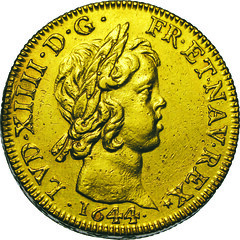

Lot 246: Louis XIV, 1643-1715. Piéfort du double louis d’or à la mèche courte. Paris, 1644. 53,91 g (quadruple weight). Extremely rare. Very fine. Estimate: 30,000 euros. Diameter: 28 mm
The Monsieur R. Collection of French Gold Coins
This brings us to France, the country that Monsieur R. was most passionate about. His collection includes 159 lots with French gold coins. The timeframe ranges from Charles V (1364-1380) to 1980. The focus is on royal and imperial issues. While many pieces have estimates in the mid-three figure range, connoisseurs will encounter some particular rarities: for example a double Henri d’or à la Gallia, struck in Paris in 1554, and a double piéfort with the childlike face of Louis XIV from 1644.


Lot 367: France. François I, 1515-1547. Teston, no year, mint of Marseilles. NGC AU55. Estimate: 4,000 euros. Diameter: 24 x 26 mm
Coins from Marseilles from the Monsieur T. Collection
78 lots with coins from the mint of Marseilles – from the Merovingian denier to small change of the Second Empire – document the numismatic past of this well-known harbour city. This offer provides you with the opportunity to purchase coins at a favourable price as part of the collection is presented in carefully assembled multiple lots. You do not need to travel to Monaco to view these multiple lots as there is a depiction of every single piece.


Lot 451: Italy / Papal States. Urban VIII, 1623-1644. Piastre, Rome, AN XX. Extremely fine. Estimate: 3,000 euros. Diameter: 43 mm
Papal Piastres, Half Piastres and Testons from the Collection of a Coin Lover
Those who are interested in coins whose reverses show more than a coat of arms are sure to appreciate papal coinage. This also applies to the coin lover who assembled the fifth collection in this catalogue. You can look forward to impressive reverse depictions and extensive multiple lots.


Lot 516: Habsburg Empire. Rudolf II. 1599 gold medal of 6 ducats by Valentin Maler. PCGS NO SERVICE, GENI AU53. Estimate: 5,000 euros. Diameter: 30 mm

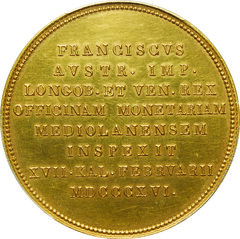
Lot 533: Habsburg Empire. Francis I, 1804-1835. 1816 gold medal commemorating the emperor’s visit to the mint of Milan on 17 February 1816. Rare. PCGS SP61. Estimate: 5,000 euros. Diameter: 37.5 mm
The "Francis" Collection: Coins of the Habsburg Empire
Although the collection focuses on the 19th century, connoisseurs will come across some very early, very rare pieces such as a gold medal of six ducats minted in 1599 with the portraits of Rudolph II and the seven electors. However, most of the coins were created under the rule of other Habsburg sovereigns starting with Joseph II. The major part of them is from the mint of Vienna, but the collection also contains other mints such as Karlsburg, Kremnica, Milan, Prague, Sofia and Venice. A small series of Serbian coins complements the collection, which comprises a total of 150 lots.


Lot 688: Transylvania. Sigismund Rákóczi, 1607-1608. 10 ducats, Kolozsvár 1607. Extremely rare. NGC AU55. Estimate: 75,000 euros. Diameter: 41 mm


Lot 715: Transylvania. Gabriel Bethlen, 1613-1629. 1629 double taler. Very rare. NGC XF40 TOP POP. Estimate: 30,000 euros. Diameter: 45 mm


Lot 720: Transylvania. Gabriel Bethlen, 1613-1629. Gold medal of 10 ducats, ca. 1620-1621. Very rare in gold. NGC AU58 TOP POP. Estimate: 75,000 euros. Diameter: 35.5 mm
The "Beyond the Woods" Collection with Coins from Transylvania
The undisputed highlight of the auction is the seventh and last collection with coins from Transylvania. Transylvania, which is at the geographical centre of Romania today and borders to the Carpathian Mountains in the east and the south, is currently one of the fields collectors are most interested in. Therefore, the 85 lots with coins from Transylvania will be in high demand, especially because they include some extremely rare and historically exciting pieces.
For example, the collection contains a tenfold ducat minted by Sigismund Rákóczi in 1607. Rákóczi was one of the richest men in the country and ruled for a short time before withdrawing to his personal life to avoid a civil war. His successor, Gabriel Bethlen, was very different, and the collection includes the spectacular 1629 double ducat of this ruler as well as two gold representational coins of 10 and 9 ducats respectively. A Calvinist, he made a pact with the Turks against the Catholic Habsburgs. With Ottoman support, he became a central figure in the Thirty Years’ War. Whether he is described as an enlightened prince or a cruel plunderer depends on which country the historian comes from. In this regard, historiography still follows the propaganda of the Thirty Years’ War.
The history of Transylvania is really exciting because it is still being the subject of hot debate today. The coins, however, tell the story of how a small region caught between the great powers of the West and the East managed to remain – relatively – independent of both for many years.
By the way, all coins were graded by NGC.
Please also take a look at our second auction preview with rare individual pieces from all over the world, from antiquity up to the 20th century.
You can order the catalogue at Éditions Victor Gadoury, 57, rue Grimaldi, 98000 Monaco; phone: +377 93 25 12 96; fax: +377 93 50 13 39; email: contact@gadoury.com.
You can find the catalogue online at auction.gadoury.com, www.sixbid.com and www.numisbids.com. Of course, it is also possible to bid live on your computer at home via www.biddr.ch!
WAYNE'S NUMISMATIC DIARY: AUGUST 11, 2024, PART II
Here's more on my experiences at the American Numismatic Association summer convention, a.k.a the World's Fair of Money®.
People
Here are some of the people I ran into my first day at the show (Wednesday, August 7, 2024).
While I didn't get a photo, I had a nice lunch across the street at Gibson's with PCGS Grader Kyle Knapp, who was recently awarded ANA honorary Doctor of Numismatics at the 2024 Summer Seminar. Kyle is also a weekly E-Sylum sponsor and advertiser for his Auditorium Books store.
Here's Hunter Hicks at the CAC booth and Jeff Zarit proudly displaying his "railroad" of ANA convention bars.
WAYNE'S NUMISMATIC DIARY: AUGUST 11, 2024, PART III
Here's more on my experiences at the American Numismatic Association summer convention - Thursday, August 8, 2024.
The Naseby Cup
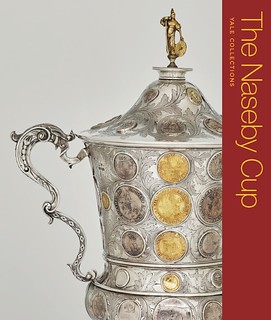 My first event was a lecture by Ben Hellings on the Yale University Art Gallery's Naseby Cup, where I sat with Neil Musante and David Fanning and picked up a copy of the book on the amazing two-foot tall cup decorated with 72 coins, medals, badges, and counters from around the time of the English Civil War period (1642–51).
My first event was a lecture by Ben Hellings on the Yale University Art Gallery's Naseby Cup, where I sat with Neil Musante and David Fanning and picked up a copy of the book on the amazing two-foot tall cup decorated with 72 coins, medals, badges, and counters from around the time of the English Civil War period (1642–51).
To read the earlier E-Sylum article, see:
NEW BOOK: THE NASEBY CUP
(https://www.coinbooks.org/v27/esylum_v27n13a03.html)
The New England Threepence
David Fanning alerted me to the New England Threepence being offered by Stack's Bowers Galleries. I took a look at it on display at the SBG table.
Heritage
Across the aisle was the Heritage booth.
The U.S Mint
The Tyrant Collection
The NBS Symposium
At the NBS Symposium Bob Leonard spoke about the upcoming edition of the California Fractional gold book. Front and side view of Bob speaking with Len Augsburger moderating.
I'll stop there for tonight. More in future issues.
To read the earlier E-Sylum article, see:
WAYNE'S NUMISMATIC DIARY: AUGUST 11, 2024, PART I
(https://www.coinbooks.org/v27/esylum_v27n32a15.html)
HOARD FOUND IN PLOVDIV, BULGARIA
Ted Banning passed along this article about a coin find in Bulgaria. Thanks. -Editor
In Plovdiv, in southern Bulgaria, archaeologists have discovered over 500 ancient coins and a gold template for making jewelry from different periods.
The coins were found during salvage excavations at the foot of the Old Town, in the Philipopol-Trimontium-Plovdiv historical zone, which is a group cultural monument.
HOARD FOUND IN GERMANY'S BLACK FOREST
A new hoard of 1,500 medieval silver coins was discovered in Germany's Black Forest. -Garrett
Archaeologists in Germany have unearthed more than 1,500 medieval silver coins after a citizen unexpectedly noticed what looked like "small metal plates" while digging during a construction project.
The discovery "is the biggest treasure since 1949 in the region of Freiburg," Andreas Haasis-Berner, an archaeologist at the State Office for Monument Preservation in Stuttgart, told Live Science in an email.
The finding, which was made in May while workers laid pipe near a swimming pool in the municipality of Glottertal, bears clues to what the mining and minting trades looked like in the area 650 years ago, according to a translated statement from the Stuttgart Regional Council.
SAMPLE SLABS HAVE GONE MAINSTREAM
In his August 2024 Sample Slab Update newsletter #37, David Schwager reported on the growth and mainstreaming of Sample Slab collecting. With permission, we're republishing the first article with a report from last week's ANA convention.
Sample Slabs are produced by third-party grading companies as examples of their work for marketing and promotional purposes. David's newsletter has grown from 25 people in 2015 to over 350 today. Congratulations. -Editor
Samples and Slabs at the 2024 ANA World’s Fair of Money
 As knowledge diffuses throughout the numismatic fraternity, it
has become more difficult to find vintage and collectible slabs
unattributed. Slab friends, we have gone mainstream. I saw
numerous NGC white labels, Blanchards, and PCGS doilies, all
priced at a premium. Even the NGC type 8 ("The Ocho") I have
been championing, that was obscure so recently, now commands
a small premium. One dealer, when asked about better holders,
noted that material of that sort was well picked at the start of the
show and I should expect to find little towards the end. You will
still find scores, but the days when we could buy every sample we
saw are over. A question to ponder: what item, whether
numismatic or anything else, is now unappreciated and will be
valuable in 10 years?
As knowledge diffuses throughout the numismatic fraternity, it
has become more difficult to find vintage and collectible slabs
unattributed. Slab friends, we have gone mainstream. I saw
numerous NGC white labels, Blanchards, and PCGS doilies, all
priced at a premium. Even the NGC type 8 ("The Ocho") I have
been championing, that was obscure so recently, now commands
a small premium. One dealer, when asked about better holders,
noted that material of that sort was well picked at the start of the
show and I should expect to find little towards the end. You will
still find scores, but the days when we could buy every sample we
saw are over. A question to ponder: what item, whether
numismatic or anything else, is now unappreciated and will be
valuable in 10 years?
A LAKI PAINTING ON A SRI LANKA BANKNOTE
The Sunday Times of Sri Lanka published a letter from Kavan Ratnatunga reporting his discovery of an unrecognized painting appearing on a Sri Lanka banknote. For more information, see Kavan's essay on his website, linked below. Nice find. -Editor
Many know that the late Laki Senanayake’s paintings were used for the flora and fauna series of Sri Lanka Currency notes issued with the date 1979-03-26.




